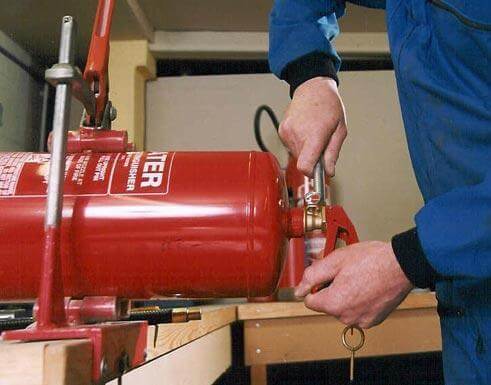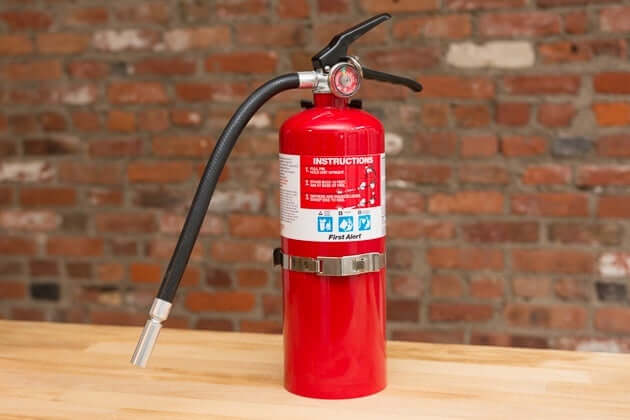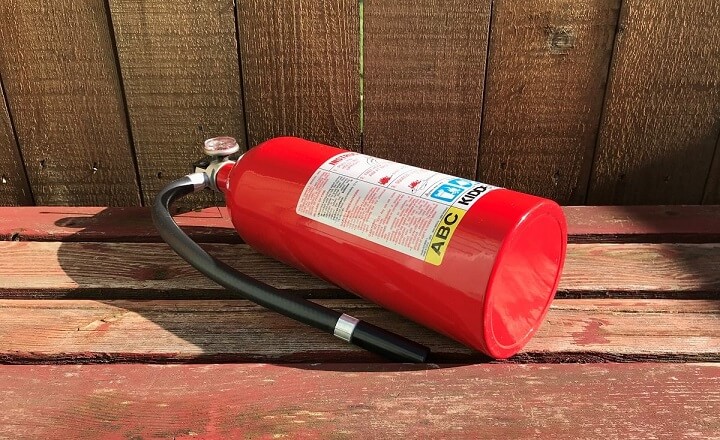Can a Fire Extinguisher Be Reused?
February 24, 2023
Can fire extinguishers be used again? The answer to this question is not as straightforward as you might think. The answer depends on a variety of factors, including the type of fire extinguisher and the severity of the fire.
This blog post will explore when it is safe to reuse fire extinguishers and when it is not. We will also provide tips for the proper disposal of fire extinguishers.
Can You Used a Fire Extinguisher More Than Once?

It’s a common question we get asked and one that doesn’t have a definitive answer. Theoretically, you could use a fire extinguisher multiple times.
However, there are a few aspects to contemplate before doing so. Here are a few things to remember if you find yourself in a situation where you need to use a fire extinguisher more than once.
Type of Fire Extinguishers
The first thing to consider is the type of fire extinguishers you have.
If you have a dry chemical extinguisher, it’s designed for single use only. The chemicals in the fire extinguisher can become airborne and potentially cause respiratory problems if used more than once.
If you have a CO₂ extinguisher, it can be used multiple times, but the pressure will decrease with each use.
Size of the Fire

Another factor to consider is the size of the fire. If the fire is large and you’re using a small fire extinguisher, you may need to use it multiple times.
In this case, it’s essential to cool the cylinder down after each discharge by holding it under running water for a few minutes. This will help prevent the pressure from building up too much and causing the cylinder to explode.
Most fire extinguishers can be used more than once, but keeping these factors in mind is essential. Using an extinguisher more than once can be done, but it’s not always the best idea.
Rechargeable and Non-Rechargeable Fire Extinguishers
There are two types of fire extinguishers: rechargeable and non-rechargeable.
Rechargeable fire extinguishers can be refilled and used again, while non-rechargeable extinguishers must be replaced after they have been used. Each type has its advantages and disadvantages, so it is crucial to choose the right one for your needs.
Rechargeable Fire Extinguishers
Rechargeable fire extinguishers have the advantage of being able to be used over and over again. This can save you money in the long run, as you will not need to purchase a new extinguisher every time it is required. They are also more reliable for a fire emergency and are less likely to malfunction.
However, a used fire extinguisher is more expensive than a non-rechargeable extinguisher and requires more maintenance.

Non-Rechargeable Fire Extinguishers
Non-rechargeable fire extinguishers are less expensive and require less maintenance, but they can only be used once. This means that you will need to purchase a new extinguisher or replacement every time one is required.
They are also not as reliable and more likely to malfunction. However, they are easier to use and can be stored in a smaller space.

When choosing fire extinguishers, it is vital to determine your needs and the type of fire you are most likely to encounter. If you are not sure which type of extinguisher is right for you, consult with your local fire department. They will be able to help you choose the best extinguishing agent for your needs.
Rechargeable fire extinguishers are a good choice for businesses or homes where fires are more likely to occur and for longer useable. Non-rechargeable extinguishers are a good choice for smaller spaces or areas where fires are less likely to occur.
Choose the correct fire extinguisher for your home’s fire protection to ensure that you are prepared for any eventuality.
How to Recharge a Fire Extinguisher
It’s essential to know how to recharge a fire extinguisher so you can be prepared in an emergency. Here are the steps you need to follow to ensure it is working correctly:
- First, remove the fire extinguisher from its mounting bracket.
- Second, turn the fire extinguisher upside down and unscrew the cap at the top.
- Third, insert the recharge hose into the opening at the top of the fire extinguisher.
- Fourth, turn on the recharging machine and allow it to run until the pressure gauge reads in the green range.
- Fifth, screw the cap back onto the fire extinguisher and replace it in its mounting bracket.
By following these simple steps, you can ensure that your fire extinguisher is recharged and ready to use in an emergency.
Who Can Refills Fire Extinguishers?
In general, it is recommended that most fire extinguishers be refilled by a certified fire professional.
However, there are some circumstances where you may be able to refill your own empty fire extinguishers.
If you have a small, portable fire extinguisher, you may be able to refill it yourself. You can usually find the instructions on how to do this on the fire extinguisher itself or in the owner’s manual.
If you have a larger fire extinguisher, it is best to have it refilled by a professional. The same is true if you are unsure how to refill your fire extinguisher properly.
Refilling a used fire extinguisher is not tricky, but it is essential to do it correctly to ensure your safety and that it will work properly in the event of a fire.
How to Recycle a Fire Extinguisher?

Recycling a used fire extinguisher is pretty simple. You’ll need to take it to your local recycling center.
- First, you’ll need to remove the pressure gauge and valve from the fire extinguisher.
- Next, you’ll need to cut off the top of the cylinder.
- Finally, you can recycle the metal cylinder at a local recycling center in your location.
So, don’t just throw it away the next time you need to get rid of an old fire extinguisher. Recycle it! It’s easy, and it’s good for the environment.
Fire Extinguisher Inspections
Fire extinguishers are essential to the home and business fire safety plans, but they must be adequately maintained to work correctly. That’s why it’s crucial to have a regular inspection schedule in place.
There are a few things that should be checked during a fire extinguisher visual inspection:
- The pressure gauge should be checked to ensure that the extinguisher is fully charged and have enough pressure.
- The extinguisher should be shaken vigorously during routine inspection to ensure the contents are mixed correctly.
- The nozzle should be checked for any blockages. Check valve stem, safety seal, expiration date, and other damage in the equipment.
- Inspect if the pin and the tamper seal are still intact and complete internal inspection.
If these maintenance procedures are not met, the fire extinguisher should be serviced or replaced or contact its service manual.
Proper Disposal of Fire Extinguishers
When old fire extinguishers are no longer usable, it must be disposed of properly. There are several ways to dispose of a fire extinguisher, depending on the type of extinguisher and the material it is made of.
Some fire extinguishers can be refilled and reused, while others must be recycled or disposed of as hazardous waste.
The best way to dispose of a fire extinguisher is to consult with your local firehouse or waste management company.
Fire extinguishers that are no longer usable can be dangerous if they are not appropriately handled.
If you are unsure how to dispose of a fire extinguisher, it is always best to avoid caution and contact a trained professional.
